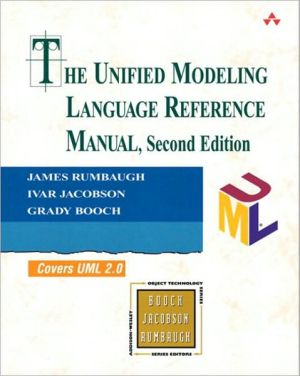

 |

|

The average rating for The Unified Modeling Language Reference Manual based on 2 reviews is 4.5 stars.
Review # 1 was written on 2010-08-10 00:00:00 James Brow James BrowAfter reading more mathematically-inclined books, such as Dijkstra's A Discipline of Programming, Stepanov's and McJones's Elements of Programming and Knuth's Literate Programming, plus a few research papers on JPL's Mission Data System, I was interested in looking at less-formal approaches. UML has something of a mixed history. In the last decade it has been picked up, at least in part, by several programmers. Even so, it hasn't been a runaway success. The reference manual contains about 100 pages of an overview of UML plus 400 pages of reference material. The overview provides a good introduction to the subject. UML provides important insights into object oriented design, improvements over traditional state charts and a decent way to depict the internals of concurrent and networked systems. The book covers things about as well as can be expected. However, now that I've had more time to consider UML, I'm no longer convinced it has an important role to play in software development. Sure, some of the charts show important data, but many of the charts are nothing more than a way for developers to waste time, and even the useful charts can easily be replaced with other ways of showing the same information. UML is meant to give a high level overview of the software in question, and it's been my experience that a high level overview is almost useless. Bugs generally lurk in the details and in the interactions that UML doesn't cover. |
Review # 2 was written on 2014-12-27 00:00:00 Brian Carruthers Brian CarruthersLike all dynamic languages, the Unified Modeling Language (UML) is growing more complex over time. While it is true that for most developers, this means that you will regularly use a smaller percentage of the language, the actual percentage will vary from person to person and from day to day. Therefore, no abridged UML manual could possibly be adequate. Written by the three creators of the UML, this manual is clearly definitive and one that all developers should have at extended arms reach. Designed to cover the changes in the recently released UML 2.0, which were significant, a CD with the full text in Adobe PDF form with hotlinks to the definitions of the key terms is also included. The opening chapter is an overview of the UML and most people can skip it. Chapter two is an overview of models, and this one is worth reading. Short, it introduces some of the fundamental terminology and approaches. A walkthrough of UML is done in chapter three, which introduces the various formal views of a project. They are: static, design, use case, state machine, activity, interaction, deployment, and model management. Each of these views is then explained in a short chapter. These chapters should be required reading for users of the book, as they establish much of the notational and definitional background used in the reference section. The real value of the book is in the five hundred plus pages of detailed definitions of the key terms and phrases in the UML. Listed in alphabetical order, each entry has the following form: *) Entry name: the term or phrase. *) A brief definition, generally one or two sentences. *) The semantics of the term, generally using several paragraphs. This section Includes the structure, subordinate items and often an example. *) The notation of usage. Options and guidelines for use are often included. *) Discussion (occasional), where the author's opinions and/or a background explanation of the term are given. *) History (where appropriate), the changes in how the term is interpreted from earlier versions of the UML. Quite frankly, I cannot see how it would be possible for any developer to use anything more than a very tiny subset of the UML if they do not have access to this book. All speakers of a language can use that language in informal communication, but when we want to communicate ideas formally and precisely, a dictionary is essential. That is the role that this book will fill, as no human communication is more precise than when we do it with notations that describe software. Published in the online Journal of Object Technology, reprinted with permission. |
CAN'T FIND WHAT YOU'RE LOOKING FOR? CLICK HERE!!!